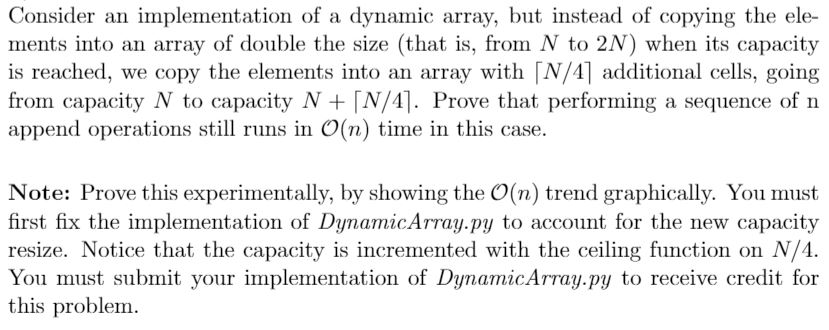Answered step by step
Verified Expert Solution
Question
1 Approved Answer
Language is Python. Using these imports. The last one is from anaconda. from time import time import matplotlib . pyplot as plt DynamicArray: import ctypes

Language is Python. Using these imports. The last one is from anaconda.
from time import time import matplotlib.pyplot as plt
DynamicArray:
import ctypes class DynamicArray(object): def __init__(self): self._n = 0 self._capacity = 1 self._A = self._make_array(self._capacity) def _make_array(self, c): return (c * ctypes.py_object)() # creates an "array" of pointers def __len__(self): return self._n def __getitem__(self, item): if not 0 item self._n: raise IndexError('invalid index') return self._A[item] # GROW THE ARRAY DYNAMICALLY def _resize(self, c): # c should be larger that the original array B = self._make_array(c) for k in range(self._n): B[k] = self._A[k] self._A = B self._capacity = c def append(self, obj): if self._n == self._capacity: # list is full self._resize(2 * self._capacity) # grow the "list" by twice its size self._A[self._n] = obj self._n += 1 # Insert... see mutating # assume 0 def insert(self, k, value): if self._n == self._capacity: # out of empty cell, must make room self._resize(2*self._capacity) # double capacity for j in range(self._n, k, -1): # shift rightmost first; -1 iterates through the range backwards self._A[j] = self._A[j-1] self._A[k] = value self._n += 1 # Pop the last element of the array def pop(self): # do not shrink the array; only allows removal of last element if self._n > 1: self._A[self._n - 1] = None # help garbage collection self._n -= 1 # one less element return Consider an implementation of a dynamic array, but instead of copying the ele- ments into an array of double the size (that is, from N to 2N) when its capacity is reached, we copy the elements into an array with N/Al additional cells, going from capacity N to capacity N LN/11. rove that performing a sequence of n append operations still runs in O(n) time in this case. Note: Prove this experimentally, by showing the O(n) trend graphically. You must first fix the implementation of DynamicArray. py to account for the new capacity resize. Notice that the capacity is incremented with the ceiling function on N/4. You must submit your implementation of DynamicArray.py to receive credit for this Step by Step Solution
There are 3 Steps involved in it
Step: 1

Get Instant Access to Expert-Tailored Solutions
See step-by-step solutions with expert insights and AI powered tools for academic success
Step: 2

Step: 3

Ace Your Homework with AI
Get the answers you need in no time with our AI-driven, step-by-step assistance
Get Started


